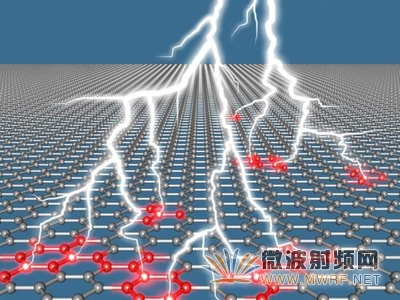德研究人员开发出基于石墨烯的太赫兹激光器
根据德国马克斯普朗克学会(Max Planck Institute)最近发布的一项报告显示,通过石墨烯可望实现高功率的太赫兹(THz)激光光源。由于目前缺少太赫兹激光,而现有可用的THz级辐射光源又相当昂贵且体积庞大,如机场安全检查站用来检查衣物底下是否暗藏玄机的安全扫描仪。如今,马克斯普朗克学会宣称已证实石墨烯能用于制作出THz级激光器,并能进一步应用于探测高温超导体。

通过外部光源激发单层石墨烯的示意图
(来源:Max Planck Institute)
石墨烯是由纯碳原子薄片组成,援引国际半导体技术蓝图(International Technology Roadmap for Semiconductors,ITRS)的预测表示,大约2023年石墨烯最终将取代硅晶微型晶片。然而,石墨烯由于缺乏能隙,因而被认为不适用于激光器。过去一向认为能隙是激光器中进行粒子数反转的必要条件,大部份材料的电子由基态(价带)穿越能隙而跃迁至激发状态(导带)然后再回到基态,并在这一过程中引发光子雪崩。
虽然石墨烯缺乏能隙,但马克斯普朗克学会的研究人员们经由实验发现,石墨烯在THz频率时经由经红外线激光激发后仍能进行粒子数反转,并产生短突波,使其在理论上应该也适用于脉冲THz激光的刺激发射。
"我们用第一个激光脉冲激发电子从价带跃迁到导带,并以光电子探测导带中的电子停留多久才开始衰减回到价带的基态,"Max Planck研究人员Isabella Gierz表示。
其结果是太赫兹波长发射长度约100飞秒左右,适于快速的脉冲激光。根据Gierz表示,许多应用都可从太赫兹激光器中受益,包括高温超导体的研究等。
"高温超导体以及其他材料在太赫兹范围内可展现多项应用启发,"Gierz表示,"除了基础研究以外,太赫兹光源可催生多项其他应用。"
截至目前为止,Gierz及其于Max Planck的研究团队们已经突破了几项障碍,期望不久后可实现一款基于石墨烯的太赫兹激光器。
"激光器由三个部分组成:可放大光源的活性介质、可供电的帮浦源,以及激光腔,"Gierz指出,"我们已经成功完成第一和第二部份了,但还需要专门设计的激光腔。"
编译:Susan Hong
原文参考:
Graphene Laser to Probe Superconductivity
PORTLAND, Ore. — Graphene could make the illusive terahertz laser possible, according to a recent report from the Max Planck Institute for the Structure and Dynamics of Matter in Hamburg. Sources of terahertz radiation, such as that used by those security scanners that look underneath your clothing at airport security checkpoints, are expensive and bulky today, and no source exists for a terahertz laser. Now, Max Planck Institute claims to have demonstrated that graphene could be used to produce terahertz lasers, which could be useful in probing high-temperature superconductors.
Graphene -- comprising atomically thin sheets of pure carbon -- is already being developed as the successor to silicon, after the end of the International Technology Roadmap for Semiconductors (ITRS)circa 2023. However, graphene was thought to be unsuitable for lasers, since it does not have a bandgap. A bandgap was previously thought to be a necessary condition for population inversion in lasers, where most of a material's electrons are boosted from their ground state (valence band)across the bandgap to their exited state (conduction band)after which they decay back to the ground state, emitting an avalanche of photons in the process.
Despite its lack of a bandgap, Max Planck researchers were nevertheless able to demonstrate population inversion in graphene at terahertz frequencies after exciting it with an infrared laser, resulting in short bursts that theoretically make it suitable for the stimulated emission of a pulsed terahertz laser.
"We use a first laser pulse to excite electrons from the valence into the conduction band and use photoemission to probe how long the electrons stay in the conduction band before they decay back to their ground state in the valence band," Max Planck researcher Isabella Gierz told EE Times.
The result was terahertz wavelength emi
- 科学家开发出石墨烯太赫兹设备样机(05-06)
- 7英寸石墨烯触摸屏重庆问世(01-23)
- 世界首台商用石墨烯飞秒光纤激光器问世(01-14)
- 中国电科13所研制出国际首只石墨烯低噪声放大器单片集成电路(07-24)
- 半导体所在石墨烯的化学掺杂及其物性研究方面取得进展(05-02)
- 金属所石墨烯三维网络结构的制备及应用研究取得重要进展(04-26)
